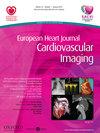LV and LA mechanics in pediatric HCM : a CMR study of phenotype-genotype correlation
引用次数: 0
Abstract
Abstract Funding Acknowledgements Type of funding sources: None. Background Paediatric hypertrophic cardiomyopathy (HCM) is a leading cause of sudden death. The relationship between the genotype variation and phenotype expression has not been fully elucidated, with some studies showing association with an increased hypertrophy and MYH7 or multiple genetic variations. In HCM fibrosis and hypertrophy contribute to left ventricular (LV) mechanics’ alteration resulting in subendocardial dysfunction. The latter is associated with a decreased global longitudinal and radial strains (GLS, GRS), whereas epicardial thickening leads to preserved global circumferential strain (GCS) and LV twist. Children with HCM have reduced LA function, measurable by both volumetric and strain analysis and reduced LA mechanics are associated with poor exercise capacity. Feature tracking –cardiac magnetic resonance (FT-CMR) has enhanced the non-invasive assessment of myocardial deformation in HCM. The main aim of our study was to assess differences of LV and LA mechanics features on CMR between patients harbouring multiple pathogenic or likely pathogenic variants (MGv, n=16) or single genetic variations (SGv, n=35). Methods Our retrospective CMR study included 51 patients (1.7–18.8 years ago). CMR data were: LV and LA’s morphological values, late gadolinium enhancement (LGE) of LA and LV walls, LV feature tracking (FT) derived strain and LV twist (LVT). LV twist was calculated as the difference between basal and apical rotation. The LA feature FT derived strain, LA conduit function, reservoir function and pump function were computed. Results In MGv group, the indexed LV mass 108.8 +/-53.0 vs 74.3+/- 22.2 in SGv (p = 0.03). LGE was present in 51% patients of the whole cohort, with LGE in 64 % of MGv group. LV FT derived strain values and LA function were not statistically significant different between groups (MGv vs SGv: GLS −15.8+/−5.3 vs −18.7+/−4.8, GCS −27.8+/8 vs −31.1+/−8.6, GRS 44.7+/−24.6 vs 62.3+/−32). LVT was reduced in MGv group (0.04+/−7.6) vs (7.4+/−7.4) in SGv (p = 0.003). LA contractile function did not differ between the groups (MGv vs SGv: GLS LA 25.1+/−14.2 vs 27.6+/−13.5). LA reservoir, conduction and pump function did not differ between the groups. LVT was significantly correlated with the LA contractile function. An increased of LVT was associated with an increased LA GLS and EF (p = 0.011; p = 0.004). Conclusions Patients with multiple genetic variants have a greater LV mass and altered LV mechanics with reduced LV twist. This study gives insights in phenotype- genotype correlation in paediatric HCM and warrants larger longitudinal studies to assess its clinical significance.儿童HCM的LV和LA机制:表型-基因型相关性的CMR研究
资金来源类型:无。背景:儿童肥厚性心肌病(HCM)是猝死的主要原因。基因型变异和表型表达之间的关系尚未完全阐明,一些研究显示与肥大和MYH7或多种遗传变异增加有关。在HCM中,纤维化和肥厚导致左心室(LV)力学改变,导致心内膜下功能障碍。后者与整体纵向和径向应变(GLS, GRS)减少有关,而心外膜增厚导致整体圆周应变(GCS)和左室扭转保留。HCM患儿的LA功能降低,可通过体积和应变分析测量,LA力学降低与运动能力差有关。特征跟踪-心脏磁共振(FT-CMR)增强了HCM心肌变形的无创评估。本研究的主要目的是评估具有多种致病或可能致病变异(MGv, n=16)或单一遗传变异(SGv, n=35)的患者在CMR时左室和左室力学特征的差异。方法回顾性CMR研究纳入51例患者(1.7 ~ 18.8岁)。CMR数据包括:左室和左室的形态学值、左室和左室壁的晚期钆增强(LGE)、左室特征跟踪(FT)衍生应变和左室扭转(LVT)。LV扭转被计算为基部和根尖旋转的差值。计算了LA特征FT衍生应变、LA导管函数、储层函数和泵函数。结果MGv组左室指数质量108.8 +/-53.0 vs SGv组74.3+/- 22.2 (p = 0.03)。整个队列中有51%的患者存在LGE, MGv组中有64%的患者存在LGE。各组间LV FT衍生应变值和LA功能差异无统计学意义(MGv vs SGv: GLS - 15.8+/−5.3 vs - 18.7+/−4.8,GCS - 27.8+/8 vs - 31.1+/−8.6,GRS 44.7+/−24.6 vs 62.3+/−32)。MGv组LVT降低(0.04+/ - 7.6),SGv组LVT降低(7.4+/ - 7.4)(p = 0.003)。两组间LA收缩功能无差异(MGv vs SGv; GLS LA 25.1+/ - 14.2 vs 27.6+/ - 13.5)。两组间LA储层、传导和泵功能无显著差异。LVT与LA收缩功能显著相关。LVT升高与LA GLS和EF升高相关(p = 0.011;P = 0.004)。结论多基因变异患者左室质量增大,左室力学改变,左室扭转减小。这项研究提供了在儿童HCM的表型-基因型相关性的见解,并保证更大的纵向研究,以评估其临床意义。
本文章由计算机程序翻译,如有差异,请以英文原文为准。
求助全文
约1分钟内获得全文
求助全文

 求助内容:
求助内容: 应助结果提醒方式:
应助结果提醒方式:


